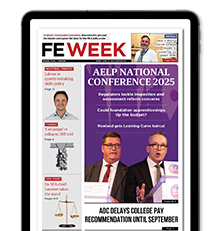We finally have the long-awaited outline of the new Ofsted inspection framework for implementation in November.
Opinions will be split on whether it is going to cause more work for providers and inspectors, is different enough to what we have now, and focuses on the right things.
And we must be careful not to jump the gun as the new inspection methodology is out for consultation and pilot inspections of FE and skills providers start this week, so further changes may be made.
So, what are the major game changers?
No overall effectiveness grade
This is the big headline change, which Ofsted states has been driven by feedback from us all during its ‘Big Listen’ consultation.
The nuanced evaluation descriptors for each of four parts of a provision type might be useful if handled correctly, but will those descriptors be that far apart anyway? Surely a ‘strong’ curriculum must result in similarly strong teaching/training, achievement and participation and development, otherwise it isn’t ‘strong’?
There are some interesting questions here too about what happens to providers that are ‘causing concern’ regarding all, or most, of the areas. What will that mean for their continued existence and ability to tender for contracts?
The evaluation scale – ‘strong’ and ‘exemplary’
I’m in favour of differentiating between the current ‘outstanding’ and ‘good’ as so many providers are not quite the former but better than the latter, which is the hole that ‘strong’ will presumably fill.
Some readers will remember the old and extremely useful ‘very good’ grade used by the adult learning Inspectorate. The fact that any ‘exemplary’ judgements now have to go before a panel to approve them should be interesting and might lead, one would think, to inspectors being wary before handing them out.
No more deep dives I think is a backwards step
No more deep dives
This suggests we are moving further away again from giving the customer an accurate view of a curriculum area at the ‘coal face’ which I think is a backwards step.
The idea that the areas to be focused on will be determined in part by leaders’ improvement priorities is an interesting idea given that many providers’ self-assessment reports, sadly, are principally still written for external audiences. And what exactly is starting from the standpoint that the provision is ‘secure’ actually going to entail?
Achievement
It’s already clear that achievement rates are going to carry greater weighting and this might ring alarm bells for some apprenticeship providers with continuing high levels of withdrawals, and employability providers with little evidence of successful job interviews and outcomes.
Given the plethora of external factors impacting negatively on apprenticeship achievement rates over the last 10 years, not least the pandemic and the move to apprenticeship standards from frameworks, the easing back of the weighting put on performance data in the current Ofsted framework has perhaps been fortunate for all concerned.
I hope not to have a return, however, to the days when provider ‘grades’ were almost predetermined by the inspectorate based on their overall achievement rate against national averages.
Inclusion
Whilst colleges will probably be very comfortable with this being a headline evaluation area given the very good work they already do in the high-needs arena under the current framework, this may send ripples of concern through the training/employer provider/local authority sectors where the arrangements to support and fund learners with additional learning needs have tended to be less clearly delineated and refined.
Longer notice periods
Although not officially part of the new framework, there is little doubt I think that revised notice periods for notification of inspection are in the pipeline.
These have already been implemented for colleges and larger training and employer providers which now get five or six days’ notice.
However, the extension is likely to be less drastic for other providers, perhaps moving the current two working days to three or four days.
On balance, I suspect most providers will value this, especially those with lots of different types of courses and/or learners located around the country which have a lot to organise pre-inspection.

















Your thoughts